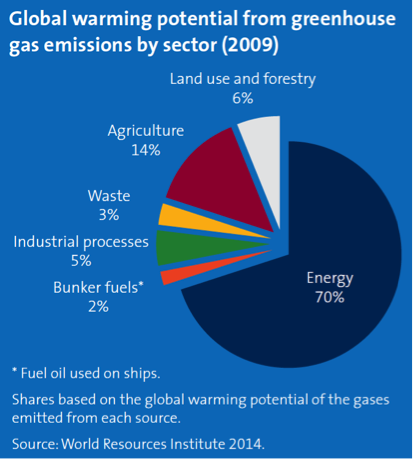The Role of Our Food Systems in Climate Change
Food systems, including agriculture, play a significant role in contributing to global warming, perhaps contributing between 19% to 29% of global anthropogenic greenhouse gas emissions (Vermeulen et al. 2012). Growing food requires energy. While the sun is the source of energy for plant growth, a majority of the energy that fuels our modern food system comes from fossil fuels (petroleum and natural gas). Petroleum is used as a fuel for tractors and other vehicles that transport food. Natural gas is used in fertilizer production and other fossils fuels are burned to generate electricity that is used in the processing and refrigeration of food. The burning of fossil fuels is our largest source of greenhouse gases globally, and food production is a significant contributor to greenhouse gases.
The Food And Agriculture Organization of the United Nations (FAO) estimates that “the food sector (including input manufacturing, production, processing, transportation marketing and consumption) accounts for around 95 exa-Joules (1018 Joules), ...— approximately 30 percent of global energy consumption — and produces over 20 percent of global greenhouse gas emissions” (from Food and Agriculture Organization of the United Nations).
In addition to carbon dioxide emissions from the fossil fuel consumption associated with agricultural activities discussed above, agriculture also contributes to greenhouse gas emissions in other ways (Figure 9.1.18). The loss of above-ground vegetation when grasslands and forests are converted to agriculture contributes about six percent of the global warming potential from greenhouse gas emissions. In addition, methane released from irrigated agriculture and from digestion and decomposition of manure from ruminants combined with nitrous oxide emissions from mismanagement of fertilizers contributes about 14 percent of the increase in total warming potential (Nelson 2014).

